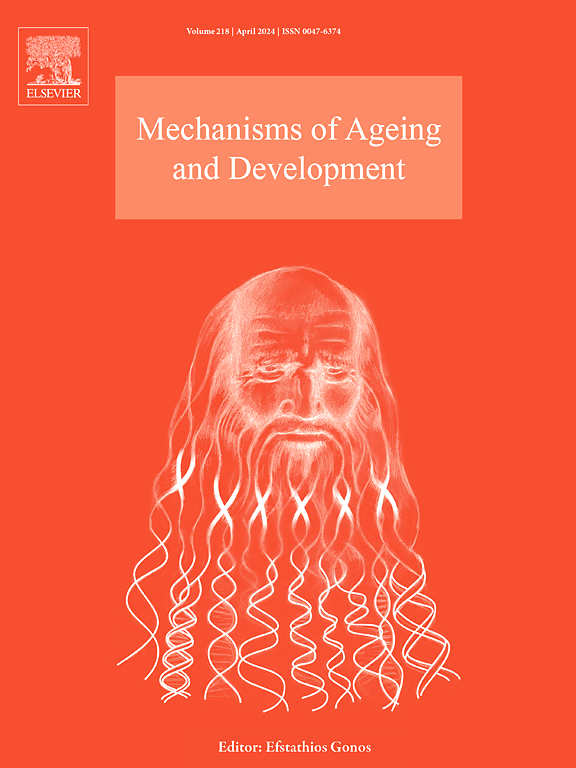延长寿命的基因操作在MJD/SCA3动物模型中的差异效应
IF 5.1
3区 医学
Q2 CELL BIOLOGY
引用次数: 0
摘要
衰老是一个自然的生物学过程,但有证据表明,衰老的某些方面可以延迟和减少神经退行性疾病的患病率,衰老是其中的一个关键风险因素。在多谷氨酰胺疾病-脊髓小脑性失调性3型(SCA3)或Machado-Joseph病(MJD)的神经元秀丽隐杆线虫模型中,我们评估了延迟衰老具有神经保护作用的假设,研究了基因操纵多种寿命决定机制的影响。寿命延长突变导致胰岛素/IGF-1信号下调、线粒体功能障碍、种系消融和饮食限制/先天免疫激活对MJD/SCA3表型有明显影响,这表明并非所有延缓衰老的遗传策略都具有同样的神经保护作用,并挑战了延缓衰老是这些疾病的保证治疗方法的观点。寿命延长仅在由胰岛素/IGF-1和饮食-2信号介导的营养传感通路改变的情况下才能改善SCA3/MJD运动表型,但它们对神经元聚集的影响不同。这些途径表现出不同的蛋白质稳态特征,但都激活了热休克反应,表明它们通过部分独立的机制起作用,赋予神经保护作用。胰岛素/IGF-1信号抑制剂对SCA3/MJD模型的慢性治疗证明了胰岛素/IGF-1下调的治疗价值,强调了衰老操纵在指导这些疾病治疗策略中的相关性。本文章由计算机程序翻译,如有差异,请以英文原文为准。
Differential effects of lifespan-extending genetic manipulations in an animal model of MJD/SCA3
Aging is a natural biological process, but evidence suggests that some aspects of aging can be delayed and reduce the prevalence of neurodegenerative diseases, for which aging is a key risk factor. In a neuronal Caenorhabditis elegans model of a Polyglutamine disease-Spinocerebellar Ataxia Type 3 (SCA3), or Machado-Joseph disease (MJD)- we assessed the hypothesis that delaying aging is neuroprotective, investigating the effect of genetically manipulating multiple lifespan-determinant mechanisms. Lifespan-increasing mutations causing insulin/IGF-1 signaling downregulation, mitochondrial dysfunction, germline ablation and dietary restriction/innate immune activation had distinct impacts on MJD/SCA3 phenotypes, suggesting that not all genetic strategies of stalling aging are equally neuroprotective and challenging the idea that delaying aging is a guaranteed therapy for these diseases. Lifespan-extension improved the SCA3/MJD motor phenotype only when induced by altered nutrient-sensing pathways such as those mediated by insulin/IGF-1 and eat-2 signaling, but their effects on neuronal aggregation differed. These pathways exhibited differential proteostasis profiles, but both activated the heat shock response suggesting that they operate through partially independent mechanisms to confer neuroprotection. The therapeutic value of the insulin/IGF-1 downregulation was demonstrated through the chronic treatment of the SCA3/MJD model with an insulin/IGF-1 signaling inhibitor, underscoring the relevance of aging manipulations in guiding therapeutic strategies for these diseases.
求助全文
通过发布文献求助,成功后即可免费获取论文全文。
去求助
来源期刊
CiteScore
11.10
自引率
1.90%
发文量
79
审稿时长
32 days
期刊介绍:
Mechanisms of Ageing and Development is a multidisciplinary journal aimed at revealing the molecular, biochemical and biological mechanisms that underlie the processes of aging and development in various species as well as of age-associated diseases. Emphasis is placed on investigations that delineate the contribution of macromolecular damage and cytotoxicity, genetic programs, epigenetics and genetic instability, mitochondrial function, alterations of metabolism and innovative anti-aging approaches. For all of the mentioned studies it is necessary to address the underlying mechanisms.
Mechanisms of Ageing and Development publishes original research, review and mini-review articles. The journal also publishes Special Issues that focus on emerging research areas. Special issues may include all types of articles following peered review. Proposals should be sent directly to the Editor-in-Chief.

 求助内容:
求助内容: 应助结果提醒方式:
应助结果提醒方式:


